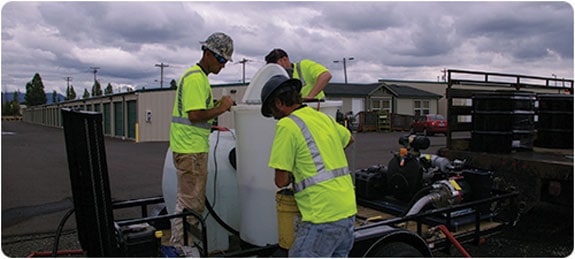
RPI-Group Approved Installers BB&A Environmental (offices in Portland and Eugene, Oregon) have been successfully remediating hydrocarbon sites for several years with BOS 200®, but had not had an opportunity to tackle a chlorinated solvent site with BOS 100®. This changed in the summer of 2012 when BB&A was contracted to test Trap & Treat® BOS 100® at an industrial site in Eugene, Oregon where a previous effort to remediate groundwater at the site using ozone for In-Situ Chemical Oxidation had proved ineffective.
The pilot test was conducted in the general vicinity of the most contaminated monitoring well on the site. Pre-injection groundwater contamination was primarily PCE (8.6 ppm), TCE (11 ppm) and 1,1,1-TCA (4.1 ppm). Weeks prior to the pilot injections, BB&A Environmental performed the RPI-Group standard Remediation Design Characterization (RDC) to provide a high-resolution, 3-dimensional, remediation-specific and speciated model of soil and groundwater contamination. RPI-Group RDCs produce a precise injection scheme targeting specific depths for BOS 100®(or BOS 200®) dosing. As with all RPI-Group RDCs, the supplemental soil and groundwater samples were analyzed at no charge at the Remediation Products, Inc. (RPI) Project Support Laboratory in Golden, Colorado.
The BOS 100® injections were completed at the end of July 2012 by BB&A Environmental (with technical support from RPI-Group BOS 100® veterans Alpine Remediation) in lithology that ranged from clays and silty clays to sandy gravel. Because the site is located in an industrial area far away from municipal water supplies, the remediation targets for the pilot test were modest. Specifically, the objective was to demonstrate reduction of contaminant concentrations in groundwater to values below occupational risk-based contaminant concentrations developed by the Oregon Department of Environmental Quality for vapor intrusion (VI) pathways rather than more stringent drinking water standards (e.g. PCE – 32 ppm, TCE -3.3 ppm). Within two weeks, concentrations of the COCs in groundwater at the pilot well had been reduced to 0.079 ppm (PCE), 0.380 ppm (TCE), and 0.230 ppm (1,1,1-TCA). Subsequent monitoring of the pilot well demonstrated that the reduction in contaminant concentrations are stable to slightly declining and remain well below the target concentrations.
As a result of this highly successful pilot test, full-scale BOS 100® injections are currently underway at the site. “Our client is very happy about what we have been able to accomplish at this site with BOS 100® and the RPI-Group approach to in situ remediation – the rapid contaminant reduction using these products is pretty amazing,” stated Randy Boese, President of BB&A Environmental.


